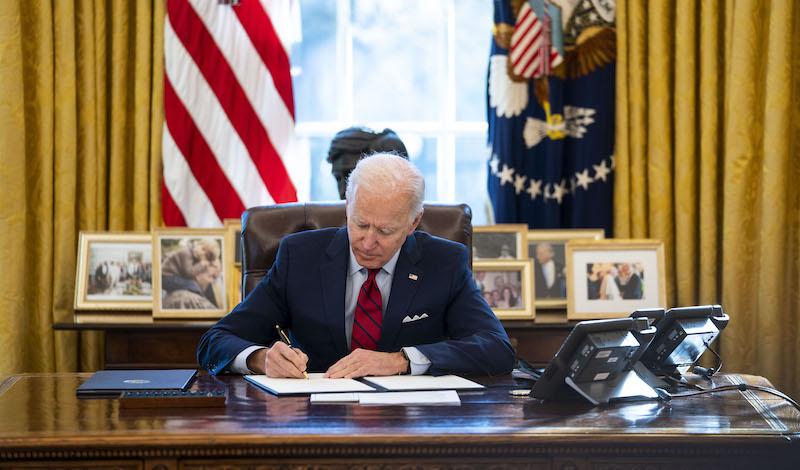
President Biden’s executive order puts forth a competitive and inclusive vision for the future of digital assets.
President Joseph R. Biden’s executive order on digital asset regulation—issued just last week—marks the White House’s first public engagement in the thicket of issues around cryptocurrencies, blockchain, central bank digital currency, and decentralized finance.
Those in the crypto community who expected an assault from regulators hell-bent on crushing a threat to traditional financial institutions are breathing a sigh of relief. Those spoiling for a showdown between centralized control and decentralized innovation may be disappointed. But make no mistake: The executive order is a major step forward.
The document sets out five primary elements. Three will get all the attention, but the other two are where White House action will have the greatest impact.
The first element calls for incorporating digital assets into the fabric of the financial regulatory system, which seeks to protect investors while also promoting capital formation. Crucial questions about digital assets currently lack sufficiently clear answers in the United States: Which activities involve securities—and therefore the Securities and Exchange Commission? What to do about activities that do not involve securities? How should digital asset exchanges and lending platforms be regulated? How can banks or other regulated financial institutions touch digital assets or keep them in custody?
Real progress on regulating digital assets will require action by the alphabet soup of federal financial regulatory authorities—SEC, CFTC, OCC, FDIC, Fed, CFPB, FinCEN, OFAC, IRS—and most likely congressional action as well. But the executive order puts the weight of the White House behind these efforts.
Similarly, financial sanctions on Russia for its invasion of Ukraine, and the arrest of two Americans for laundering billions of dollars of bitcoin, have placed a spotlight on the illicit finance and national security implications of digital assets. From the beginning, it has been clear that cryptocurrencies, which are tracked on public ledgers and typically hosted at exchanges that are potential points of interdiction, do not present a “get out of jail free” card to the world’s criminals and rogue states. Questions remain, however, about how to ensure the appropriate level of surveillance and enforcement without overly compromising financial privacy or eliminating efficiency benefits. The executive order promotes a nuanced view coupled with greater priority on addressing existing harms.
The second element of the executive order is to promote and maintain U.S. competitiveness in a global financial system in which digital assets are increasingly important. Specifically, the executive order “places the highest urgency on research and development efforts” into a potential U.S. central bank digital currency (CBDC). Ever since China announced the digital currency research project it started in 2017, which culminated in the country’s e-CNY “digital yuan,” concern has grown that the dollar’s global dominance is under threat. The Federal Reserve Bank of Boston developed a CBDC proof of concept with the MIT Digital Currency Initiative. But the United States trails behind places such as China, England, and the European Union in investigating how a CBDC might overcome the limitations of existing payment rails and provide a new foundation for monetary policy.
The executive order appropriately does not commit the United States to a particular way of moving forward. CBDCs are not a race that will be won by those first out of the gate. The United States cannot afford, however, to cede the stage entirely to other nations to reinvent currencies for the networked digital era.
The third piece of the executive order concerns financial stability and systemic risk. As David Zaring and I argue in a forthcoming law review article, the macroprudential framework of financial regulation, which emphasizes systemic resilience, is worth emulating in related contexts. Compared to traditional sectors of the financial marketplace, the digital asset sector is different — the whole idea is that everything does not run through centralized control points . Yet perhaps it is not really so different. Holdings of most digital assets are heavily concentrated, and a small number of actors have significant power in the market. Because decentralized finance platforms are interoperable and programmable, they may create significant hidden risks through interconnection.
The executive order directs the Financial Stability Oversight Council, the interagency body created by the Dodd-Frank Wall Street Reform and Consumer Protection Act, to address systemic risks created by digital assets. This directive, more than anything else, reflects the growth and maturation of the sector. Only a few years ago, central banks dismissed digital assets as too small and separate from the rest of the financial system to pose systemic risks.
The final two elements of the executive order will get the least press. Yet they are critical for the healthy development of the digital asset sector.
The fourth major pillar is financial inclusion. Proponents of digital assets argue they give retail investors, average consumers, and marginalized groups better access to financial services. Digital assets can remove barriers imposed by banks and other institutions while pushing greater control and ownership out to individuals. Similarly, non-fungible tokens might provide creators with better channels to connect with their audiences. Yet these marginalized groups are still vulnerable to scams, hacks, and hidden arrangements. With the executive order, the U.S. government is now on record as promoting the inclusiveness of digital assets as a policy objective.
Finally, it is easy to forget that, despite the size of digital asset trading markets, the underlying technology remains immature. Major blockchain networks are not sufficiently scalable, secure, and interoperable. Important infrastructure elements around digital identity and governance are at a fledgling stage. And the energy use of mining for cryptocurrency networks such as Bitcoin is now a serious matter of concern around the world.
Just as in other critical areas such as artificial intelligence, the European Union and China are ahead of the United States in funding research and promoting standards development. The executive order engages non-regulatory components of the federal government, such as the National Science Foundation and the White House Office of Science and Technology Policy, in the cause of promoting technical advancements in digital assets and blockchain technology.
The executive order is just a start. But it is important to recognize the difficulty of reaching the starting line. Herding the necessary cats, when there are so many agencies, viewpoints, and personalities involved, is a monstrous effort. Engaging the President and other top officials amid a global pandemic, and now a war in Europe, further adds to the degree of difficulty. The text of the executive order comprises mostly requests for studies and the setting up of working groups, but that is how the machinery of public policy works in the federal government.
Saber-rattling speeches by agency heads and senators may make better headlines. Yet this executive order is a turning point. It will elevate digital assets as a topic of public policy concern and force all relevant components of the federal government to engage.




